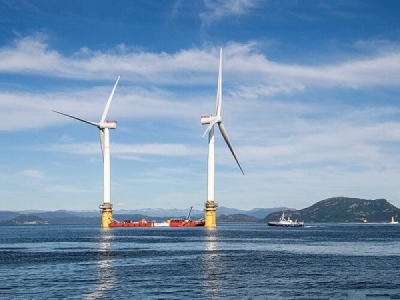
Posted on April 12, 2020
By David Thill, ecoRI News
As offshore wind moves up the coast of New England, efforts are underway to make sure the region’s fishing interests have a seat at the table early in project development.
An alliance of industry and academic stakeholders is promoting the need for research and best practices as offshore wind takes hold in waters where fishing has long been an economic anchor.
Fishing groups have several concerns about the potential for boating obstacles and ecological impacts. A dearth of research makes the industry hesitant as it prepares for a slew of projects that could overwhelm their operations.
Above all, fishing stakeholders want to be included from the start of offshore wind development.
Wind and fishing advocates say they don’t want another kind of dispute like the one that led federal authorities to delay the permitting process for the Vineyard Wind offshore project in federal waters off Massachusetts. An ongoing environmental review by the U.S. Bureau of Ocean Energy Management has raised uncertainty for 14 other projects in the region.
Those types of disputes are “what we’re trying to avoid happening now,” said Annie Hawkins, executive director of the Responsible Offshore Development Alliance. The coalition of fishing stakeholders aims to get the industry on the same page as researchers and wind developers.
“We’re trying to make sure fishermen are much more involved in the process from day one,” said Hawkins, adding that she would like to see more work across state lines to coordinate policy and research.
Research has been slow, but it’s going to be important with such rapid development planned. Floating turbines, which will be common in deep waters like the Gulf of Maine, are especially uncertain.
“We don’t know a lot about them,” said Andrew Lipsky, fisheries and offshore wind lead at the Northeast Fisheries Science Center, a division of the National Oceanic and Atmospheric Administration.
One floating turbine pilot is in the works. Researchers at the University of Maine for several years have been planning a project off Monhegan Island. It was stalled during the administration of Maine’s previous governor, Paul LePage. But in November, under Gov. Janet Mills’ administration, the state’s public utilities commission approved a power-purchase agreement between Maine Aqua Ventus, the small company set up to coordinate the project, and Maine Central Power.
Initial plans involved two 6-megawatt turbines, but technology has changed since the project began in 2014. Bigger turbines are more common now, said Habib Dagher, a professor and the project lead at the University of Maine. The team is now planning for a single 9.5- to 10-megawatt turbine.
Hawkins said the network of cables between floating turbines means fishing vessels have two obstacles to contend with: many boats will be too big to navigate between turbines and the facility as a whole could cause a roadblock for fishing operations. Without strategic planning, fishermen could lose huge sources of their product, she said.
Dagher said his team is working with fishing stakeholders to research the potential impacts of floating turbines on the region’s fisheries.
Offshore wind development is an important issue going forward for other fishing-related organizations, such as Massachusetts Lobstermen’s Association. Beth Casoni, the association’s executive director, said far more of her members have operations in the gulf than they do further south.
She said offshore wind is the organization’s second-biggest issue, after North Atlantic right whale protection concerns. But after wind comes online in the Gulf of Maine, she noted, that will be the top concern for members.
“Offshore wind developers are actively partnering with the fishing industry,” said Laura Morton, senior director of policy and regulatory affairs for offshore wind at the American Wind Energy Association. “The developers have held hundreds of meetings with the fishermen and fishing groups, and we certainly are looking for ways to expand our engagement.”
Part of the focus now is making the complicated regulatory process clearer for people who aren’t involved in policy discussions every day, including fishermen. One new resource is a public participation guide developed by the American Wind Energy Association and the Special Initiative on Offshore Wind, a policy and research group housed at the University of Delaware.
The participation guide, released in January, breaks down the timeline of the federal planning process for offshore wind projects, including public comment periods. That way, stakeholders can more easily know when they can get involved in discussions, said Nancy Sopko, the initiative’s executive director.
“It’s very important to have that early, often, and continuous engagement with the public from the developer’s perspective,” she said.
Referring to the delay on the Vineyard Wind project, she said, “We understand that there are existing users of the ocean and federal agencies like NOAA that are, understandably, cognizant that there is a pipeline of offshore wind projects in the queue, and there should be a thorough investigation of how those projects would affect oceans, ocean users, and marine life.”
She added that once the current review process is thoroughly completed, her team is hopeful the Vineyard Wind project and others planned for the region will move forward.
Energy News Network is a fellow Institute of Nonprofit News (INN) member that has a content-sharing agreement with ecoRI News.
Source: ecoRI News





